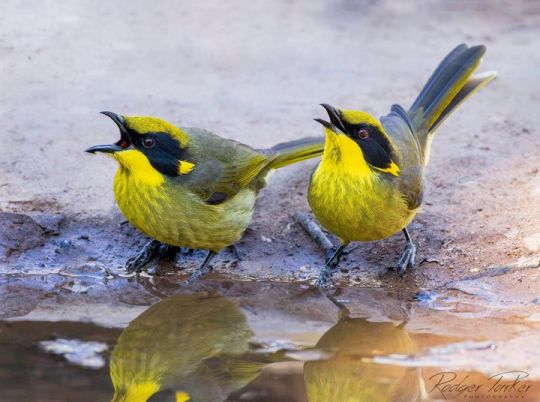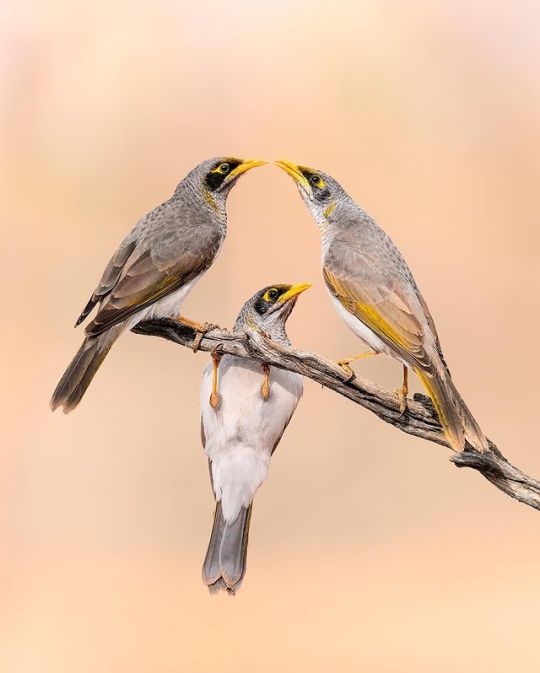#Honeyeater
Explore tagged Tumblr posts
Text
yeah facebook is terrible but sometimes you stumble across pure gold. there are dream animals i want to see in the wild and there will be posts like

ma'am that is the critically endangered regent honeyeater. There are less than 300 of them left in the wild
#the anklet indicates captive breed and released BUT STILL#i want to see one so bad this is so funny to me#birds#regent honeyeater#Anthochaera phrygia#bird#honeyeater#australian animals#fauna#conservation#wildlife
20K notes
·
View notes
Text
"In short:
Victorian farmers and volunteers have planted 750,000 trees to restore habitat for a critically endangered bird.
The Regent Honeyeater Project has brought together volunteers from all walks of life since it was launched in the 1990s.
What's next?
An ornithologist says the project is working wonders for the species and other wildlife.
--
John Paul Murphy is not an ecologist, but he knows a thing or two about trees.
The young cattle farmer from Winton in north-east Victoria has helped plant more than 750,000 trees as part of the Regent Honeyeater Project.
"Our involvement as a family goes back to the early 1990s, when the project first kicked off," Mr Murphy said.
The regent honeyeater is a critically endangered bird known for its black-and-bright-yellow colouring.

"Back in the day, millions of these birds would darken the sky from Adelaide up to Queensland," ornithologist Maggie Watson said.
"They're quite large compared to other honeyeaters, are highly nectar-dependent, and are one of the main pollinators of eucalypt trees."
Dr Watson, based in Burrumbuttock, New South Wales, said habitat fragmentation was a major reason the bird was threatened.
"When people started clearing farmland as part of colonisation in the 1800s, they removed all the productive, nectar-producing trees," she said.
"So that essentially wiped out the regent honeyeater's main food-base."
'Great for all wildlife'
Benalla cattle farmer and Regent Honeyeater Project president Rob Richardson said agriculture had claimed its share of the environment.
"We've destroyed a lot of habitat to create grazing and cropping land to the point where there are less than 500 wild regent honeyeaters left in Australia," he said.
"So now we're trying to restore the balance.
"We propagate all the trees in our plant nursery, and then plant them across the landscape to establish vegetation corridors."
Dr Watson said the project would significantly benefit the regent honeyeater population.
"The birds need to have 'roads' to get to flowering trees like eucalypts, and those roads happen to be other trees — so the more you plant, the better," she said.
"Tackling habitat fragmentation is great for all wildlife."
Huge volunteer effort
Mr Richardson said local volunteers were at the heart of the project.
"Over the last 30 years we've had many farmers donate land to be revegetated and over 40,000 volunteers help plant all the trees," he said.
Mr Murphy said the volunteers came from all walks of life.
"At our planting days, I've met university students, doctors, lawyers, biologists … and many of them come back year after year," he said.
Mr Murphy said it was nice to have a chance to get to know with people he may not otherwise have met.
"Farming can be pretty isolating," he said.
"But when you're planting, learning, and just getting your hands dirty together, the conversations you have are really unique.""
-via ABC News Australia, December 2, 2024
#birds#ornithology#australia#honeyeater#bird photography#wild birds#birdblr#endangered species#ecosystem restoration#habitat#conservation#good news#hope
714 notes
·
View notes
Text

Spinebill honeyeater By: M. K. Morcombe From: The Fascinating Secrets of Oceans & Islands 1972
#eastern spinebill#honeyeater#passeriform#bird#1972#1970s#M. K. Morcombe#The Fascinating Secrets of Oceans & Islands
339 notes
·
View notes
Text

Yellow-tufted Honeyeaters (Lichenostomus melanops), family Meliphagidae, order Passeriformes, VIC, Australia
photograph by Rodger Parker
746 notes
·
View notes
Text

The MacRegor’s Honeyeater is a reclusive species, living in isolated pockets on the island of New Guinea. They nest in the crowns of trees in cloud forests and subalpine Dacrycarpus forests at elevations between 2,800 - 4,000m. They are monogamous breeders, with mating pairs laying a single pink and spotted egg per season.
144 notes
·
View notes
Note
Blue-faced honeyeater if it hasn't been done yet


#australian bird#new guinea#blue-faced honeyeater#bananabird#honeyeater#meliphagidae#passeriformes#australian birds#birds#bird#wild birds#animal polls#poll blog#my polls#animals#polls#tumblr polls
88 notes
·
View notes
Text

December 24, 2024 - Sulawesi Myzomela (Myzomela chloroptera) Found in Indonesia on Sulawesi and several nearby islands, these honeyeaters live in lowland and mountain forests, including mangroves. They eat nectar, foraging in flowering trees, mistletoes, and parasitic shrubs alone, in pairs, or in small groups, and sometimes joining mixed-species flocks. Their breeding habits are unknown.
68 notes
·
View notes
Text


57 notes
·
View notes
Text

Black-eared Miner
412 notes
·
View notes
Text
Blue-faced Honeyeater (Entomyzon cyanotis)
167 notes
·
View notes
Text

White-plumed honeyeater after a bath
63 notes
·
View notes
Text

(x)
listen, i love honeyeaters as much as the next guy. but why is the Spiny-cheeked Honeyeater Like That.

(x)
👁️👅👁️
85 notes
·
View notes
Text


making an attempt at gpose again...! i might tackle this again later, bc i'm not satisfied in the slightest-- but! eh
61 notes
·
View notes
Text

Yellow-fronted honeyeater By: M. K. Morcombe From: The Fascinating Secrets of Oceans & Islands 1972
#yellow-faced honeyeater#honeyeater#passeriform#bird#1972#1970s#M. K. Morcombe#The Fascinating Secrets of Oceans & Islands
185 notes
·
View notes
Text

Yellow-tufted Honeyeaters (Lichenostomus melanops), BATH TIME!!!, family Meliphagidae, order Passeriformes, VIC, Australia
Photograph by Dean Hohn
460 notes
·
View notes
Text

Day 16 of Pied Month! Honeyeater? More like Honeyeatrans!
Reference photo by David Sinnott
I'm on Cara, it's a social media for art that's anti-AI, follow me @ tbalderdash
#pied month#pride month#trans#trans pride#pied honeyeater#honeyeater#certhionyx variegatus#meliphagidae#passeriformes#bird#birb#birds#bird art#ornithology#art#digital art#tw eyestrain#cw eyestrain#wauk wauk
43 notes
·
View notes
